Small scale breeder farms still thriving in Vietnam
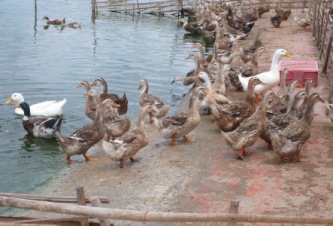
Back yard farming in South Vietnam still plays a significant role in duck production, for both meat and egg bird types. Nam Mong has specialised in supplying day-old-ducklings to farmers from his small-scale hatchery for decades. Thus, he is successfully meeting local demand.
By Apisit Buranakanonda, Bangkok, Thailand
Nam Mong, a duck breeder farm owner in Long An province in South Vietnam, has kept his breeding business for over three decades. He sells Peking broiler ducklings while developing his own dual-purpose layer breeder stock. He has continuously improved the genetics of his Peking drake by obtaining the parent stock from the Vigova -Southern Livestock Research and Advanced Technology Transfer Centre.Long An, located 50 kilometres south of Ho Chi Minh city, is a vast rice basin with an abundant water resource, making it an ideal site for free grazing. As a result, small hatcheries are almost everywhere in Long An. Some hatcheries are running their own breeder farms while some opt to buy hatching eggs.
Dual-purpose breeder
There is a segment in South Vietnam that prefers dual-purpose duck because of sizable egg weight and acceptable bodyweight at depletion, while customers in the north and central areas prefer single purpose, either layer or meat-type duck.Nam has developed his medium-frame dual-propose duck, which yields a good egg number while the bodyweight at depletion is 3 kg close to the broiler duck. He uses the Khaki Campbell female to cross with the white feather Peking drake. Currently he is working on the 3rd generation and the selection is still ongoing. The selection is based on feather colour and body frame, which should not be too heavy like the Peking duck. The bodyweight of the female at the beginning of lay is capped at 3 kg, larger female ducks will not be selected for the breeding programme. If the progeny is too close to the Peking, the egg number will be fewer and also the egg laying period will be shorter. The Khaki Campbell is chosen because it yields over 300 eggs/duck/year with egg size varying between 65-75 grams.
There is a segment in South Vietnam that prefers dual-purpose duck because of sizable egg weight and acceptable bodyweight at depletion, while customers in the north and central areas prefer single purpose, either layer or meat-type duck.Nam has developed his medium-frame dual-propose duck, which yields a good egg number while the bodyweight at depletion is 3 kg close to the broiler duck. He uses the Khaki Campbell female to cross with the white feather Peking drake. Currently he is working on the 3rd generation and the selection is still ongoing. The selection is based on feather colour and body frame, which should not be too heavy like the Peking duck. The bodyweight of the female at the beginning of lay is capped at 3 kg, larger female ducks will not be selected for the breeding programme. If the progeny is too close to the Peking, the egg number will be fewer and also the egg laying period will be shorter. The Khaki Campbell is chosen because it yields over 300 eggs/duck/year with egg size varying between 65-75 grams.
Nam keeps the bodyweight of the dual-purpose drake to 2.8-3 kg, heavier than the Khaki Campbell drake, bodyweight 2.2-2.4 kg. Also, the egg weight is heavier than the Khaki Campbell.
Nam Mong in South Vietnam is a veteran duck farmer with 30 years of experience in breeding. He uses locally made incubators, each holding 4,800-5,200 eggs, depending on egg size.
52 week laying period
The duck will start laying at 22-24 weeks. Production will reach its peak in 6-8 weeks and then start to decline. The drake duck ratio is 1:7-8 with hatchability 80%, sellable duckling 70% or 120 ducklings/duck. The egg production period lasts 52 weeks. The flock will then be depleted; with bodyweight at depletion being 3 kg. The market price of the depleted breeder is around 1.25 USD/kg.Nam keeps his PS farm stocked with 2,500 dual-purpose breeders and 2,500 meat-type breeders. Each barn is divided into six sections, 12 x 30 m with swimming ponds in front of the barn. The optimal stocking area is 1m2 of swimming area per duck. One section holds 250 layer ducks or 180 broiler ducks. According to Nam, a duck prefers clean water. Poor water quality adversely affects the duck health and egg number. During production, good water quality therefore is maintained. Some tilapia are also kept in the pond. The nesting area is closed during the daytime and opened in the evening. Eggs are collected early in the morning. The floor eggs are collected several times a day to prevent the duck from broodiness or breakages. The barn is cleaned and left fallow for one month before starting the next crop.
The duck will start laying at 22-24 weeks. Production will reach its peak in 6-8 weeks and then start to decline. The drake duck ratio is 1:7-8 with hatchability 80%, sellable duckling 70% or 120 ducklings/duck. The egg production period lasts 52 weeks. The flock will then be depleted; with bodyweight at depletion being 3 kg. The market price of the depleted breeder is around 1.25 USD/kg.Nam keeps his PS farm stocked with 2,500 dual-purpose breeders and 2,500 meat-type breeders. Each barn is divided into six sections, 12 x 30 m with swimming ponds in front of the barn. The optimal stocking area is 1m2 of swimming area per duck. One section holds 250 layer ducks or 180 broiler ducks. According to Nam, a duck prefers clean water. Poor water quality adversely affects the duck health and egg number. During production, good water quality therefore is maintained. Some tilapia are also kept in the pond. The nesting area is closed during the daytime and opened in the evening. Eggs are collected early in the morning. The floor eggs are collected several times a day to prevent the duck from broodiness or breakages. The barn is cleaned and left fallow for one month before starting the next crop.
Multi-stage incubation
Due to the size of the operation, with new hatching eggs coming every day with no egg storage room, the multi-stage incubator is practical.
Due to the size of the operation, with new hatching eggs coming every day with no egg storage room, the multi-stage incubator is practical.
Hatching takes place in large racks, simply made of wood and usually covered with a blanket.
The eggs are disinfected, set tipped point down in the incubator and manually turned every 1.5 hours. The average setting egg weight is 80-90 grams and the incubation period is 28 days. Eggs are set in a forced draft incubator in the first 21 days. The incubator has a large fan circulating air throughout the interior of the incubator to maintain constant temperatures and relative moisture. There is a water trough at the bottom of the incubator. In case the relative humidity is too low, workers will open the incubator and sprinkle the eggs with lukewarm water.
Egg candling is done on the fifth day of incubation. From that moment, the infertile eggs are still good enough for selling. The eggs are moved to hatchers which is simply a large rack made of wood and covered with a blanket. The duckling will start to pip on day 26. The newly hatched will be separated, sorted and packed in bamboo baskets before delivering to the customers. The hatch window is 48 hours.Prices of ducklings are seasonal. In the Mekhong River Delta, ducklings fetch higher prices in March, July and November because the growing stock can be scavenging in rice fields after harvest. Rice harvest season in irrigated areas are March-April; July-August and October-December.
Ducklings hatch from day 26 with a hatch window of usually 48 hours.
Pellet feed preferred
In the pond rearing system, hard pellets are preferred for stability. The pellet durability index (PDI) is above 96%. Typical commercial feed presents a pellet length of 1 cm with a diameter of 4-4.5 mm. The drawback of a very hard pellet is the high pelletising temperature above 95oC causing a significant loss of vitamins and poor enzyme activities in the finished feed. The layer duck would require protein 18-19%, energy 2,650 Kcal/kg whereas the Peking breeder requires protein 20% during the production. Adding extra oil to raise energy does not only increase cost, but also effects pellet hardness. Ducks tends to take less high-energy feed compared to the low energy feed. As a result, Nam regularly tops up the feed with paddy rice; up to 30% of the daily allowance of 220-250 grams/day. Also, dried fish is added from time to time. However, the quality of dry fish is important as poor quality dry fish could be contaminated with salmonella and too much salt could cause diarrhoea.
In the pond rearing system, hard pellets are preferred for stability. The pellet durability index (PDI) is above 96%. Typical commercial feed presents a pellet length of 1 cm with a diameter of 4-4.5 mm. The drawback of a very hard pellet is the high pelletising temperature above 95oC causing a significant loss of vitamins and poor enzyme activities in the finished feed. The layer duck would require protein 18-19%, energy 2,650 Kcal/kg whereas the Peking breeder requires protein 20% during the production. Adding extra oil to raise energy does not only increase cost, but also effects pellet hardness. Ducks tends to take less high-energy feed compared to the low energy feed. As a result, Nam regularly tops up the feed with paddy rice; up to 30% of the daily allowance of 220-250 grams/day. Also, dried fish is added from time to time. However, the quality of dry fish is important as poor quality dry fish could be contaminated with salmonella and too much salt could cause diarrhoea.
The breeders are subject to bird flu vaccination. The first vaccination starts at 2 weeks of age, followed by 5 and 21 weeks. The broiler ducks are vaccinated only twice at 2 weeks and 5 weeks old. The birds are vaccinated against duck plague.
Broiler ducklings are delivered to customers in bamboo baskets.
Free grazing system
Nam stopped free grazing following a bird flu outbreak in 2003. Nevertheless, free grazing is still commonly practiced in Long An and the Mekhong Delta area. Some landowners may charge a land use fee of up to 15–20 USD/hectare. In this case, production costs are less because the ducks are scavenging the rice fields littered with grains of rice, grass, fish, insects, small amphibians, worms, and small molluscs found in the rice field during the grow out. The duck will be tended in the rice field for a few weeks before taking back for fattening and sale. Average overall mortality is around 2%. Herders release the ducks early in the morning and herd them back to the pens in the evening. The duck must be vaccinated against avian influenza and the duck owners must have the transportation permit which clearly state the destination where the ducks will be raised. For small-scale farms, the government offers a vaccination service free of charge. This is applicable for backyard farmers, keeping less than 500 birds.
Nam stopped free grazing following a bird flu outbreak in 2003. Nevertheless, free grazing is still commonly practiced in Long An and the Mekhong Delta area. Some landowners may charge a land use fee of up to 15–20 USD/hectare. In this case, production costs are less because the ducks are scavenging the rice fields littered with grains of rice, grass, fish, insects, small amphibians, worms, and small molluscs found in the rice field during the grow out. The duck will be tended in the rice field for a few weeks before taking back for fattening and sale. Average overall mortality is around 2%. Herders release the ducks early in the morning and herd them back to the pens in the evening. The duck must be vaccinated against avian influenza and the duck owners must have the transportation permit which clearly state the destination where the ducks will be raised. For small-scale farms, the government offers a vaccination service free of charge. This is applicable for backyard farmers, keeping less than 500 birds.
 Beheer
Beheer

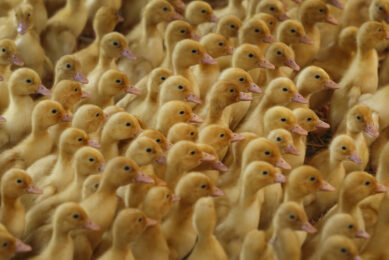
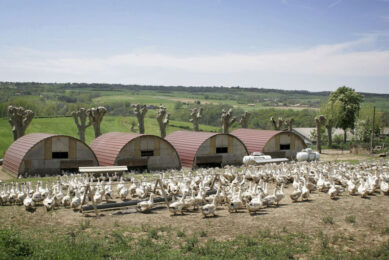
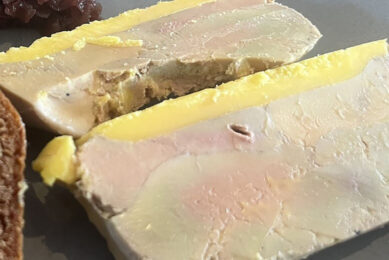
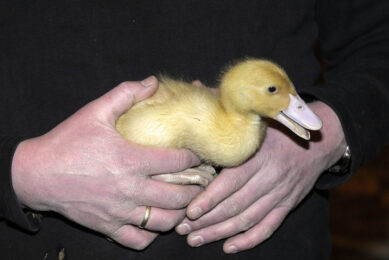



 WP Admin
WP Admin  Bewerk bericht
Bewerk bericht